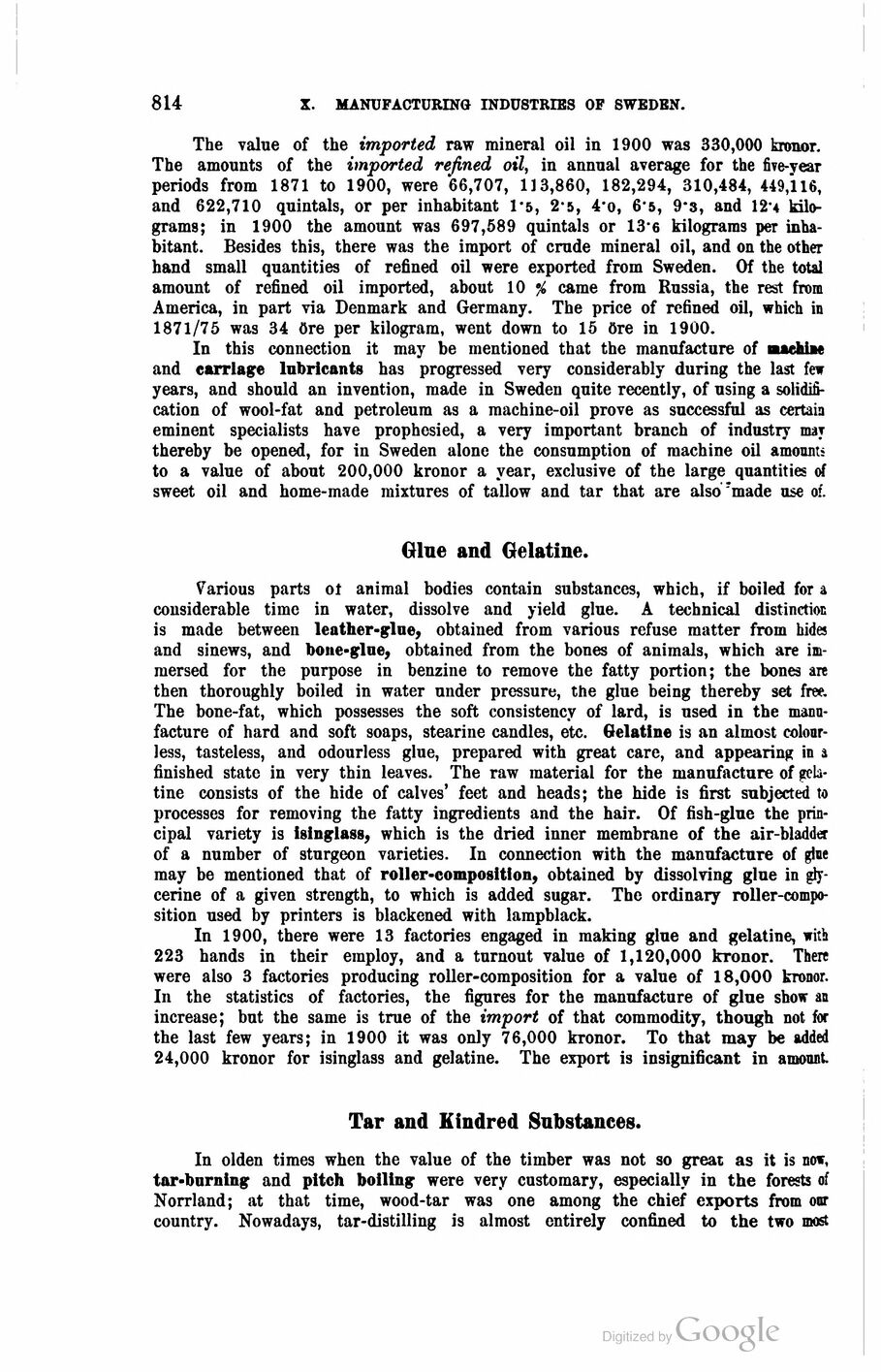
Full resolution (JPEG) - On this page / på denna sida - Second part - X. Manufacturing Industries. By Å. G. Ekstrand, Ph. D., Chief Engineer, Control Office of the Department of Finance - 4. Oils, Tar, India-rubber, and kindred commodities - Mineral Oil (Petroleum) - Glue and Gelatine - Tar and Kindred Substances

<< prev. page << föreg. sida << >> nästa sida >> next page >>
Below is the raw OCR text
from the above scanned image.
Do you see an error? Proofread the page now!
Här nedan syns maskintolkade texten från faksimilbilden ovan.
Ser du något fel? Korrekturläs sidan nu!
This page has never been proofread. / Denna sida har aldrig korrekturlästs.
814
x. manufacturing industries of 8wedbn.
The value of the imported raw mineral oil in 1900 was 330,000 kronor.
The amounts of the imported refined oil, in annual average for the fWe-vear
periods from 1871 to 1900, were 66,7 0 7, 113,860, 182,294, 310,484, 449,116,
and 622,710 quintals, or per inhabitant 1*5, 2-5, 4-o, 6’5, 9"3, and 124
kilograms; in 1900 the amount was 697,589 quintals or 13"6 kilograms per
inhabitant. Besides this, there was the import of crude mineral oil, and on the other
hand small quantities of refined oil were exported from Sweden. Of the total
amount of refined oil imported, about 10 % came from Russia, the rest from
America, in part via Denmark and Germany. The price of refined oil, which in
1871/75 was 34 öre per kilogram, went down to 15 öre in 1900.
In this connection it may be mentioned that the manufacture of ucUm
and carriage lubricants has progressed very considerably during the last few
years, and should an invention, made in Sweden quite recently, of using a
solidification of wool-fat and petroleum as a machine-oil prove as successful as certain
eminent specialists have prophesied, a very important branch of industry may
thereby be opened, for in Sweden alone the consumption of machine oil amounts
to a value of about 200,000 kronor a year, exclusive of the large quantities of
sweet oil and home-made mixtures of tallow and tar that are also "made use of.
Glue and Gelatine.
Various parts ot animal bodies contain substances, which, if boiled for a
considerable time in water, dissolve and yield glue. A technical distinction
is made between leather-glue, obtained from various refuse matter from hides
and sinews, and bone-glue, obtained from the bones of animals, which are
immersed for the purpose in benzine to remove the fatty portion; the bones are
then thoroughly boiled in water under pressure, the glue being thereby set free.
The bone-fat, which possesses the soft consistency of lard, is used in the
manufacture of hard and soft soaps, stearine candles, etc. Gelatine is an almost
colourless, tasteless, and odourless glue, prepared with great care, and appearing in a
finished state in very thin leaves. The raw material for the manufacture of
gelatine consists of the hide of calves’ feet and heads; the hide is first subjected to
processes for removing the fatty ingredients and the hair. Of fish-glue the
principal variety is isinglass, which is the dried inner membrane of the air-bladder
of a number of sturgeon varieties. In connection with the manufacture of glne
may be mentioned that of roller-composition, obtained by dissolving glue in
glycerine of a given strength, to which is added sugar. The ordinary
roller-composition used by printers is blackened with lampblack.
In 1900, there were 13 factories engaged in making glue and gelatine, witb
223 hands in their employ, and a turnout value of 1,120,000 kronor. There
were also 3 factories producing roller-composition for a value of 18,000 kronor.
In the statistics of factories, the figures for the manufacture of glue show an
increase; but the same is true of the import of that commodity, though not for
the last few years; in 1900 it was only 76,000 kronor. To that may be added
24,000 kronor for isinglass and gelatine. The export is insignificant in amount.
Tar and Kindred Substances.
In olden times when the value of the timber was not so great as it is now,
tor-burning and pitch boiling were very customary, especially in the forests of
Norrland; at that time, wood-tar was one among the chief exports from oor
country. Nowadays, tar-distilling is almost entirely confined to the two most
<< prev. page << föreg. sida << >> nästa sida >> next page >>